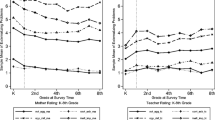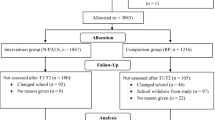Abstract
In a sample of 405 children assessed in kindergarten through the seventh grade, we determined the basic developmental trajectories of mother-reported and teacher-reported externalizing and internalizing behaviors using cross-domain latent growth modeling techniques. We also investigated the effects of race, socioeconomic level, gender, and sociometric peer-rejection status in kindergarten on these trajectories. The results indicated that, on average, the development of these behaviors was different depending upon the source of the data. We found evidence of the codevelopment of externalizing and internalizing behaviors within and across reporters. In addition, we found that African-American children had lower levels of externalizing behavior in kindergarten as reported by mothers than did European-American children but they had greater increases in these behaviors when reported by teachers. Children from homes with lower SES levels had higher initial levels of externalizing behaviors and teacher-reported internalizing behaviors. Males showed greater increases in teacher-reported externalizing behavior over time than did the females. Rejected children had trajectories of mother-reported externalizing and internalizing behavior that began at higher levels and either remained stable or increased more rapidly than did the trajectories for non-rejected children which decreased over time.
Similar content being viewed by others
REFERENCES
Achenbach, T. M. (1991a). Manual for the Child Behavior Checklist/4-18 and 1991 Profile. Burlington, VT: University of Vermont Department of Psychiatry.
Achenbach, T. M. (1991b). Manual for the Teacher's Report Form and 1991 Profile. Burlington, VT: University of Vermont Department of Psychiatry.
Achenbach, T. M., McConaughy, S. H., & Howell, C. T. (1987). Child/adolescent behavioral and emotional problems: Implications of cross-informant correlations for situational specificity. Psychological Bulletin, 101, 213-232.
Angold, A. (1988). Childhood and adolescent depression: I. Epidemiological and aetiological aspects. British Journal of Psychiatry, 152, 601-617.
Bates, J., Pettit, G., Dodge, K. A., & Ridge, B. (1998). Interaction of temperamental resistance to control and restrictive parenting in the development of externalizing behavior. Developmental Psychology, 34, 982-995.
Beyers, J., Bates, J. E., Dodge, K. A., Pettit, G. S. (1999). Neighborhood, family, and individual characteristics and the development of children's externalizing behaviors problem (1999). Manuscript submitted for publication.
Bollen, K. A. (1989). Structural equations with latent variables. NY: John Wiley.
Bryk, A. S., & Raudenbush, S. W. (1992). Hierarchical linear models in social and behavioral research: Applications and data analysis methods. Newbury Park, CA: Sage.
Burks, V. S., Dodge, K. A., & Price, J. M. (1995). Models of internalizing outcomes of early rejection. Development and Psychopathology, 7, 683-695.
Cohen, P., Cohen, J., Kasen, S., Velez, C. N., Hartmark, C., Johnson, J., Rojas, M., Brook, J., & Struening, E. L. (1993). An epidemiological study of disorders in late childhood and adolescence. I. Ageand gender-specific prevalence. Journal of Child Psychology and Psychiatry, 34, 851-867.
Coie, J. D., Lochman, J. E., Terry, R., & Hyman, C. (1992). Predicting early adolescent disorder from childhood aggression and peer rejection. Journal of Consulting and Clinical Psychology, 60, 783-792.
Coie, J. D., Terry, R., Lenox, K., Lochman, J., & Hyman, C. (1995). Childhood peer rejection and aggression as predictors of stable patterns of adolescent disorder. Development and Psychopathology, 7, 697-713.
Conduct Disorder Prevention Research Group (1992). A developmental and clinical model for the prevention of conduct disorder: The FAST Track program. Development and Psychopathology, 4, 509-527.
Conger, R. D., Conger, K. L., Elder, G. J., Jr., Lorenze, F. O., Simons, R. L., & Whitbeck, L. B. (1992). A family process model of economic hardship and adjustment of early adolescent boys. Child Development, 63, 526-554.
DeRosier, M. E., Kupersmidt, J. B., & Patterson, C. J. (1994). Children's academic and behavioral adjustment as a function of the chronicity and proximity of peer rejection. Child Development, 65, 1799-1813.
Dishion, T. J., Duncan, T. E., Eddy, J. M., Fagot, B. I., Fetrow, R., Social Learning Center, Eugene, OR (1994). The world of parents and peers: Coercive exchanges and children's social adaptation. Social Development, 3(3), 255-268.
Dishion, T. J., Patterson, G. R., & Kavanagh, K. A. (1992). An experimental test of the coercion model. In J. McCord & R. Trembley (Eds.), The interaction of theory and practice: Experimental studies of interventions (pp. 253-282). New York: Guilford Press.
Dodge, K. A. (1993). The future of research on the treatment of conduct disorder. Development and Psychopathology, 5, 311-319.
Dodge, K. A., Coie, J. D., & Brakke, N. P. (1982). Behavior patterns of socially rejected and neglected preadolescents: The roles of social approach and aggression. Journal of Abnormal Child Psychology, 10, 389-410.
Dodge, K. A., Pettit, G. S., & Bates, J. E. (1994). Socialization mediators of the relation between socioeconomic status and child conduct problems. Child Development, 65, 649-665.
Dodge, K. A., Price, J. M., Coie, J. D., & Christopoulos, C. (1990). On the development of aggressive dyadic relationships in boys' peer groups. Human Development, 33, 260-270.
Duncan, G. J., Brooks-Gunn, J., & Klebanov, P. K. (1994). Economic deprivation and early childhood development. Child Development, 65, 296-318.
Fleming, J. E., & Offord, D. R. (1990). Epidemiology of childhood depressive disorders: A critical review. Journal of the American Academy of Child and Adolescent Psychiatry, 29, 571-580.
Garber, J., & Hilsman, R. (1992). Cognitions, stress, and depression in children and adolescence. Child and Adolescent Psychiatric Clinics of North America, 1(8), 129-167.
Gottman, J. (1977). Toward a definition of social isolation in children. Child Development, 48, 513-517.
Hilsman, R., & Garber, J. (1995). A test of the cognitive diathesis-stress model of depression in children: Academic stressors, attributional style, perceived competence, and control. Journal of Personality and Social Psychology, 69, 370-380.
Hinshaw, S. P., Han, S. S., Erhardt, D., & Huber, A. (1992). Internalizing and externalizing behavior problems in preschool children: Correspondence among parent and teacher ratings and behavior observations. Journal of Clinical Child Psychology, 21, 143-150.
Hinshaw, S. P., Lahey, B. B., & Hart, E. (1993). Issues of taxonomy and comorbidity in the development of conduct disorder. Development and Psychopathology, 5, 31-39.
Hollingshead, A. B. (1975). Four factor index of social status. Unpublished manuscript. Department of Sociology, Yale University.
Kazdin, A. E. (1993). Treatment of conduct disorder: Progress and directions in psychotherapy research. Development and Psychopathology, 5, 277-310.
Kupersmidt, J. B., & Coie, J. D. (1990). Preadolescent peer status, aggression, and school adjustment as predictors of externalizing problems in adolescence. Child Development, 61, 1350-1362.
Lahey, B. B., Loeber, R., Hart, E. L., Frick, P. J., Applegate, B., Zhang, Q., Green, S. M., & Russo, M. F. (1995). Four-year longitudinal study of conduct disorder in boys: Patterns and predictors of persistence. Journal of Abnormal Psychology, 104, 83-93.
Little, S. A., & Garber, J. (1995). Aggression, depression, and stressful life events predicting peer rejection in children. Development and Psychopathology, 7, 845-856.
Lochman, J. E., & Wayland, K. K. (1994). Aggression, social acceptance, and race as predictors of negative adolescent outcomes. Journal of the American Academy of Child and Adolescent Psychiatry, 33, 1026-1035.
Loeber, R., & Farrington, D. P. (1994). Problems and solutions in longitudinal and experimental treatment of child psychopathology and delinquency. Journal of Consulting and Clinical Psychology, 62, 887-900.
Loeber, R., Green, S. M., Keenan, K., & Lahey, B. B. (1995). Which boys will fare worse? Early predictors of the onset of conduct disorder in a six-year longitudinal study. American Academy of Child and Adolescent Psychiatry, 34, 499-509.
Loeber, R., & Hay, D. F. (1994). Developmental approaches to aggression and conduct problems. In M. Rutter & D. F. Hay (Eds.), Development through life: A handbook for clinicians. Oxford: Blackwell Scientific Publications.
Loeber, R., & Keenan, K. (1994). Interaction between conduct disorder and its comorbid conditions: Effects of age and gender. Clinical Psychology Review, 14, 497-523.
Loeber, R., Lahey, B. B., & Thomas, C. (1991). Diagnostic conundrum of oppositional defiant disorder and conduct disorder. Journal of Abnormal Psychology, 100, 379-390.
Loeber, R., Russo, M. F., & Stouthamer-Loeber, M. (1994). Internalizing problems and their relation to the development of disruptive behaviors in adolescence. Journal of Research on Adolescence, 4, 615-637.
Loeber, R., Wung, P., Keenan, K., Giroux, B., Stouthamer-Loeber, M., VanKammen, W. B., & Maughan, R. (1993). Developmental pathways in disruptive child behavior. Development and Psychopathology, 5, 103-133.
McArdle, J. J., & Hamagami, F. (1991). Modeling incomplete longitudinal and cross-sectional data using latent growth structural models. In L. M. Collins & J. L. Horn (Eds.), Best methods for the analysis of change. Washington, DC: American Psychological Association.
McFadyen-Ketchum, S. A., Bates, J. E., Dodge, K. A., & Pettit, G. S. (1996). Patterns of change in early childhood aggressive-disruptive behavior: Gender differences in predictions from early coercive and affectionate mother-child interactions. Child Development, 67, 2417-2433.
McLoyd, V. C. (1990). Minority children: Introduction to the special issue. Child Development, 61, 311-346.
Metalsky, G. I., Halberstadt, L. J., & Abramson, L. Y. (1987). Vulnerability to depressive mood reactions: Toward a more powerful test of the diathesis-stress and causal mediation components of the reformulated theory of depression. Journal of Personality and Social Psychology, 52, 386-393.
Offord, D. R., & Bennett, K. J. (1994). Conduct disorder: Long-term outcomes and intervention effectiveness. Journal of the American Academy of Child and Adolescent Psychiatry, 33, 1069-1078.
Ollendick, T. H., Weist, M. D., Borden, M. C., & Greene, R. W. (1992). Sociometric status and academic, behavioral, and psychological adjustment: A five-year longitudinal study. Journal of Consulting and Clinical Psychology, 60, 80-87.
Panak, W. F., & Garber, J. (1992). Role of aggression, rejection, and attributions in the prediction of depression in children. Development and Psychopathology, 4, 145-165.
Parker, J. G., & Asher, S. R. (1987). Peer relations and later personal adjustment: Are low-accepted children at risk? Psychological Bulletin, 102, 357-389.
Patterson, G. R. (1994). Some alternatives to seven myths about treating families of antisocial children. In C. Henricson (Ed.), Crime and the family: Conference report: Proceedings of an international conference (pp. 26-49). London: Family Policy Studies Center.
Patterson, G. R., Reid, J. B., & Dishion, T. J. (1992). Antisocial boys. Eugene, OR: Castalia.
Rutter, J. (1986). The development of psychopathology of depression: Issues and perspectives. In M. Rutter, C. E. Izard, & P. B. Read (Eds.), Depression in young people (pp. 3-30). New York: Guilford Press.
Spencer, M. B., & Dupree, D. (1996). African-American youths' ecocultural challenges and psychosocial opportunities: An alternative analysis of problem behavior outcomes. In D. Cicchetti & S. L. Toth (Eds.), Rochester symposium on developmental psychopathology, Vol. 7: Adolescence: Opportunities and challenges (pp. 259-282). Rochester: University of Rochester Press.
Vuchinich, S., Bank, L., & Patterson, G. R. (1992). Parenting, peers, and the stability of antisocial behavior in preadolescent boys. Developmental Psychology, 28, 510-521.
Walden, T., & Garber, J. (1994). Emotional development. In M. Rutter, D. Hay, & S. Baron-Cohen (Eds.), Developmental principles and clinical issues in psychology and psychiatry. London: Blackwell.
Willett, J. B. (1994). Measuring change more effectively by modeling individual growth over time. In T. Husen & T. N. Postlethwaite (Eds.), The international encyclopedia of education, 2nd Edition. Oxford, UK: Pergamon Press.
Willett, J. B., & Sayer, A. G. (1994). Using covariance structure analysis to detect correlates and predictors of individual change over time. Psychological Bulletin, 116, 363-381.
Willett, J. B., & Sayer, A. G. (1996). Cross-domain analyses of change over time: Combining growth modeling and covariance structure analysis. In R. Schumacher & G. Marcoulides (Eds.), Advanced structural equation modeling techniques. Hillsdale, NJ: Erlbaum.
Willett, J. B., Singer, J. D., & Martin, N. C. (1998). The design and analysis of longitudinal studies of development in context: Statistical models and methodological recommendations. Development and Psychopathology, 10, 395-426.
Author information
Authors and Affiliations
Rights and permissions
About this article
Cite this article
Keiley, M.K., Bates, J.E., Dodge, K.A. et al. A Cross-Domain Growth Analysis: Externalizing and Internalizing Behaviors During 8 Years of Childhood. J Abnorm Child Psychol 28, 161–179 (2000). https://doi.org/10.1023/A:1005122814723
Issue Date:
DOI: https://doi.org/10.1023/A:1005122814723




